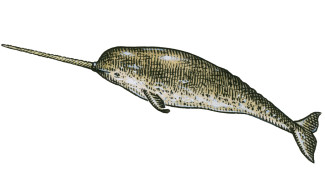The precise function of narwhal tusks has puzzled scientists for years—is it used to stab fish, to joust, or as a sensory organ? Here are the facts. The narwhal is known as the "unicorn of the ocean" and is famous for its incredible spiral tusks, if not for a silly cartoon song.

The tusk, which consists of a hollow left canine protruding from the male narwhal's upper lip, is between 1.5 and 3 meters long and weighs just 10 kilograms.
An unusual appendage, ivory has been the subject of many legends. One of the legends tells of an Inuit woman holding a harpoon who was dragged out to sea by a whale, transforming into a narwhal in the process. Her spirally knotted hair turned into the famous tusks.
During medieval times, it was believed that narwhal tusks, derived from unicorns, had the power to cure a variety of illnesses. The Vikings capitalized on these legends, selling them for many times their weight, while Queen Elizabeth purchased a carved and gem-set ivory for £10,000 - a considerable sum in the 16th century Number of!
However, not everyone was fooled. In 1555, the Swedish monk Olaus Magnus, who mistakenly drew a swallow hibernating underwater, correctly identified the "narwhal" in a drawing of the horned fish-like animal. ".
But what are their tusks used for?
sexual issues
While female narwhals have shorter, straighter tusks, longer, spiral tusks are usually only found in males. So one explanation might be that it's a secondary sexual characteristic, much like a stag's antlers or a peacock's tail.
Deer use their antlers to display good health and to ensure breeding rights with females. The overall size serves as a visual cue to deter potential rivals with smaller antlers, while they can also be used against any challenger. At the same time, the peacock's tail is unusually large and bulky, showing how powerful individual peacocks must be to cope with this high visual burden.
Maybe narwhals use their tusks in a similar way?
Bull narwhals are known to engage in "tusking," in which individuals rub their tusks together, which helps measure tusk length and determine social rank. In the absence of identification of individuals with longer tusks, it is possible that the tusks were used for fighting or as swords. Or can it?
In his 1870 novel Twenty Thousand Leagues Under the Sea, Jules Verne mentions a seemingly giant narwhal that impales ships with its tusks. Although it has not been reported in reality, maybe it can also function as a weapon?
It seems unlikely.
Narwhals have rarely been observed using their tusks to attack other narwhals, and the "tusking" behavior between male narwhals appears to be a passive interaction.
The tusk was also too long and slender to be used for chipping away at sea ice, and it was of little use as a spear because it would be difficult to remove a speared item from the tusk.
sixth sense
The ivory's lack of enamel covering and porous outer surface means it is exposed to the narwhal's environment. Therefore, ivory may be sensitive to temperature and chemical signals. The center of an ivory is made up of the pulp, which, like our teeth, contains nerve endings that carry messages to the brain.
New research suggests that ivory may have been a sensory organ. Research shows that when narwhals are exposed to water of varying salinities, their heart rates change significantly, which may identify a response that helps narwhals locate fish, find mates or predict when seawater will freeze. This prevents getting trapped.
Because narwhals are relatively unknown, they haven't received much scientific scrutiny over the past few years, leaving us with this enduring question.
In the meantime, what do you think?
animal tags: Narwhal
We created this article in conjunction with AI technology, then made sure it was fact-checked and edited by a Animals Top editor.